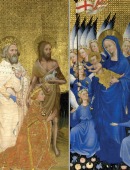
Meditations by Blessed John Henry Newman on the Mysteries of the Rosary
Article:
30.04.19
To celebrate the forthcoming canonisation of Blessed John Henry Newman, we reprint these Meditations on the Rosary, compiled from his writings by a Benedictine Sister at St Cecilia’s Abbey, Ryde. In this May issue we offer the Joyful Mysteries: subsequent issues of FAITH will offer the Luminous, Sorrowful and Glorious Mysteries.
The Annunciation (PS ii, 12, pp.131-2)
Who can estimate the holiness and perfection of her, who was chosen to be the Mother of Christ. If to him that hath, more is given, and holiness and Divine favour go together (and this we are expressly told), what must have been the transcendent purity of her whom the Creator Spirit condescended to overshadow with His miraculous presence? What must have been her gifts, who was chosen to be the only near earthly relative of the Son of God, the only one whom he was bound by nature to revere and look up to; the one appointed to train and educate Him, to instruct Him day by day, as He grew in wisdom and in stature?
The Visitation (PS vi, 22, p.314)
Take St Mary’s hymn…She was no woman of high estate, the nursling of palaces and the pride of a people, yet she was chosen to an illustrious place in the Kingdom of heaven. What God began in her was a sort o type of His dealings with His Church. So she spoke of His scattering the proud, putting down the mighty, exalting the humble and meek, filling the hungry with good things, and sending the rich empty away (Lk 1.46-53). This was a shadow or outline of that Kingdom of the Spirit, which was then coming on earth.
The Nativity (PS ii,3, p. 32)
He came into this world, not in the clouds of heaven, but born into it, born of a woman; He the Son of Mary, and she (if it may be said) the mother of God. Thus He came, selecting and setting apart for Himself the elements of body and soul; then, uniting them to Himself from their first origin of existence, pervading them, hallowing them by His own Divinity, spiritualizing them, and filling them with light and purity, the while they continued to be human, and for a time mortal and exposed to infirmity. And as they grew from day to day in their holy union, His Eternal Essence still was one with them, exalting them, acting in them, manifesting Itself through them, so that He was truly God and man, One Person-as we are soul and body, yet one man, so truly God and man are not two, but one Christ. Thus did the Son of God enter this mortal world.
The Presentation (PS vi,9, pp.112-113)
Though it is not called a sign, yet it had been published in the manner of a sign, that the Lord should suddenly come to His Temple, even the Messenger of the Covenant (Mal. 3.1)… But how did he come to fufil these prophecies? As an infant in arms, recognized by one or two holy persons, and that by means of faith, without pomp, or display of greatness. Simeon held in his hands the immaculate form of the Saviour of men, the Light and Life of the world, the all-holy and incorruptible Presence which the Angels of God worship; yet in what an outward appearance! Yet still he said undoubtingly, Mine eyes have seen Thy salvation; a light to lighten the Gentiles,
The Finding in the Temple (US 15, p. 313)
When her Son and Saviour … had been found, to her surprise, in the Temple, amid the doctors, … and had on her addressing Him, vouchsafed to justify His conduct, we are told, His mother kept all these sayings in her heart (Lk 2.51)…. Thus St Mary is our pattern of faith, both in the reception and in the study of Divine Truth. She does not think it enough to accept, she dwells upon it; not enough to possess, she uses it; not enough to assent, she develops it; not enough to submit the Reason, she reasons upon it; not indeed reasoning first, and believing afterwards, with Zacharias, yet first believing without reasoning, next from love and reverence, reasoning after believing. And thus she symbolizes to us, not only the faith of the unlearned, but of the doctors of the Church also, who have to investigate, and weigh, and define, as well as to profess the Gospel; to draw the line between truth and heresy; to anticipate or remedy the various aberrations of wrong reason; to combat pride and recklessness with their {314} own arms; and thus to triumph over the sophist and the innovator.
Notes:
St Cecilia's Abbey can be contacted at www.stceciliasabbey.org.uk





